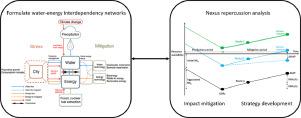Resources, Conservation and Recycling ( IF 13.2 ) Pub Date : 2021-04-27 , DOI: 10.1016/j.resconrec.2021.105628 Li-Heng Chen , Pei-Chiun Li , Yupo Lin , I-Chun Chen , Hwong-wen Ma , Chang-Ping Yu

|
Bioenergy plays a pivotal role in replacing fossil fuels, limiting carbon emissions, and supporting the transformation of low-carbon societies. However, bioenergy crop production requires irrigation and the presence of specific soil and weather conditions, resulting in certain environmental impacts due to uneven resource allocation and depletion. Nexus repercussions occur when activities in an individual sector are mismanaged and impact other nexus sectors. This study applies a quantitative nexus approach to quantify, clarify, manage, and mitigate the repercussions and interlinkages between the water, energy, and land sectors. An assessment process is established to locate cultivable idle land, evaluate water availability, and estimate additional energy consumption. Districts are categorized into three groups based on their bioethanol capacity and water availability and are assigned development priorities. Undesirably, many districts that possess the most extensive suitable idle land are projected to face water challenges, so nexus repercussion analysis is applied to develop mitigation strategies, restrain intersystem impact dissemination effects, and sufficiently utilize their capacities. The range of expected mitigation achievement points for these districts varies from 8 million m3 to 66 million m3. Some districts can reach positive water availability and achieve a mitigation ratio higher than 50%. Districts are able to eliminate nexus repercussions from energy consumption and effectively reduce the pressures of water shortages. This study can help policymakers comprehend the limitations of regional water-energy interdependency networks (WEINs) and help them govern nexus repercussions at a manageable level, avoid runaway dissemination occurrences, and strengthen the resilience of WEINs.
中文翻译:

建立水系相互依赖网络中环境影响的量化过程,以减轻对环境的影响
生物能源在替代化石燃料,限制碳排放以及支持低碳社会转型方面起着关键作用。但是,生物能源作物的生产需要灌溉,并需要特定的土壤和天气条件,由于资源分配和消耗不均,对环境造成了一定影响。当单个部门中的活动管理不当并影响其他联系部门时,就会发生连结影响。这项研究采用定量联系方法来量化,澄清,管理和减轻水,能源和土地部门之间的影响和相互联系。建立评估过程以定位可耕地的闲置土地,评估水的可利用性并估算额外的能源消耗。根据地区的生物乙醇容量和水的可利用性,将地区分为三类,并为其分配发展优先级。不利的是,许多拥有最合适闲置土地的地区预计将面临水的挑战,因此将联系反冲分析用于制定缓解策略,限制系统间影响的传播效果并充分利用其能力。这些地区的预期缓解成就点范围为800万平方米 并充分利用他们的能力。这些地区的预期缓解成就点范围为800万平方米 并充分利用他们的能力。这些地区的预期缓解成就点范围为800万平方米3至6600万立方米3。一些地区可以达到正的水供应量,并且可以达到50%以上的缓解率。各地区能够消除能源消耗中的联系影响,并有效减轻缺水压力。这项研究可以帮助决策者理解区域水能相互依赖网络(WEIN)的局限性,并帮助他们在可管理的水平上控制联系的影响,避免失控的传播事件,并增强WEIN的弹性。



























 京公网安备 11010802027423号
京公网安备 11010802027423号